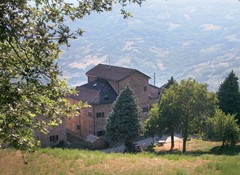Palagano between past and present
Palagano was first mentioned in a document from 1144, a period when the village was one of the most populous in the lands belonging to Frassinoro Abbey. With the decline of the monastery founded by Beatrice of Lorraine, the mother of Matilda of Canossa, Palagano was taken over by Modena.
After 1321, Palagano became a fiefdom of the Montecuccoli family, already lords of Medola, and it remained in their hands until 1534, when Alfonso I d’Este gave it to the Mosti from Ferrara, who held on to it under the name of the County of Rancidoro for 240 years, until the bloodline died out. After being subordinated to the Este ducal chamber , in 1741, the County and Palagano with it passed to the Sabbatini of Fanano, who held onto it until the French Revolution and the suppression of feudal privileges.
There are many historic itineraries to be followed in and around Palagano, where medieval history is interwoven with the more recent events of the last war.
As a memento of the Counts Mosti-Este – who were lords of the fiefdom of Rancidoro and Medola from the 16th until the 17th century – is the feudal palace at Palagano, which they rarely lived in, since they usually resided in Ferrara, and during their sporadic appearances in the County preferred to stay at the fortress of Rancidoro.
The palace, formerly known as the Castellazzo, was probably built on top of the ruins of an ancient fortification. In fact during rebuilding work, the remains of a tower with heavy walls were discovered. The old feudal residence, to which is annexed a small oratory dedicated to Saint Anthony, did however undergo various alterations between the 17th and 19th centuries.
Another imposing building is the eighteenth-century palace which overlooks the village, built by the Sabbatini Counts from Fanano in 1741, when Francesco III d’Este granted the County of Rancidoro to Count Alessandro Sabbatini. The particularity of this set of buildings, consisting of the owner’s residence and two lateral service buildings – the stables and the servants’ quarters – is the complete absence of angles in the stonework which have been replaced by curvilinear walls.
A step forward in history takes us to the Second World War, which for the local populations was intense and dramatic. Chased by the Partisan troops, during its retreat the German army left a sad trail of victims in its wake. Memorial stones and monuments remind us of the carnage of those times.
One of the most significant and evocative places of this secular memory is at Monchio, the Monte Santa Giulia Resistance Park, 28 hectares of splendid parkland.
At the entrance to the Park is the "Santa Giulia Memorial" an imposing set of sculptures comprising 14 monoliths created by contemporary artists of different nationalities, symbolizing peace, liberty and fraternity.
Still inside the park, on the summit of Monte Santa Giulia, in a place of extraordinary beauty framed by an enchanting scenario dominated by the Cimone peak, lies the lonely church, “Pieve dei Monti”, dedicated to Santa Giulia – Saint Julia.
Destroyed during the Second World War, its reconstruction, which largely respected the original appearance, dates to the 1950s.
Documented for the first time in 1197 it had a square ground plan, a rarity amongst Romanesque churches. Of the ancient building, now of an elongated shape with three apses, all that remains inside are three capitals, part of a column base and three cymatia of pillars, with the naves separated by two lines of columns.
